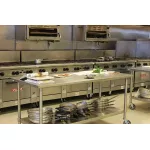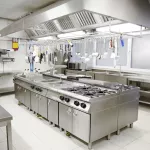A Guide to Choosing Tables for Your Space

Stainless steel tables are versatile and essential fixtures in various environments, such as commercial kitchens, laboratories, hospitals, and manufacturing facilities. They offer durability, hygiene, and functionality, making them a popular choice for many industries. However, selecting the right size and style of table requires careful consideration to ensure optimal utilization of space and seamless workflow. In this guide, we will explore the factors to consider when choosing the size and style of tables, along with helpful tips for measurement and customization.
Before delving into the selection process, it is important to understand the benefits of those tables. Stainless steel is a sturdy material known for its resistance to corrosion, heat, and stains. It is easy to clean and maintain, making it ideal for environments where cleanliness is paramount. Tables also provide a hygienic surface for food preparation, laboratory work, and other tasks that require stringent sanitation measures. Additionally, stainless steel is durable, ensuring that your investment will last for years to come.
Factors to Consider for Size Selection
- Available Space
The first factor to consider when choosing a stainless steel table is the available space in your facility. Measure the area where you plan to place the table, taking into account any adjacent fixtures or equipment. Ensure that there is sufficient room for users to move comfortably around the table without hindrance.
- Intended Use
The intended use of the table is another crucial consideration. Determine the tasks that will be performed on the table and assess the space required for those activities. For example, if you need a table for food preparation, consider the amount of countertop space needed for chopping, slicing, and other culinary tasks.
- Number of Users
If multiple individuals will be using the table simultaneously, consider the number of users when selecting the size. Each user should have enough workspace to carry out their tasks comfortably. Factor in any additional equipment or tools that may be required on the table, such as scales, mixers, or cutting boards.
- Ergonomics
Ergonomics plays a significant role in creating a comfortable and efficient workspace. Ensure that the table height allows users to work without straining or bending excessively. Consider the average height of the users and adjust the table accordingly. Ergonomic tables contribute to better productivity and reduce the risk of work-related injuries.
Factors to Consider for Style Selection
- Design Aesthetics
The style of the table should complement the overall design aesthetics of your space. Consider the existing decor and choose a style that blends seamlessly with the surroundings. Whether you prefer a sleek and modern design or a more traditional look, there are various options available to suit your taste.
- Functionality
The functionality of the table is essential in determining the appropriate style. Different styles cater to specific tasks and requirements. For instance, worktables typically feature an open base for easy access and storage, while prep tables often come with built-in sinks or cutting boards. Consider the primary function of the table and select a style that accommodates those needs.
- Durability
Stainless tables are known for their durability, but the level of durability can vary among different styles. Some styles may have reinforced structures or additional features to withstand heavy use or load-bearing requirements. If you anticipate heavy-duty usage, opt for a style that offers enhanced durability to ensure the longevity of your investment.
- Maintenance
Consider the maintenance requirements of the table style you choose. Some styles may have intricate designs or additional features that could make cleaning and maintenance more challenging. Ensure that the style you select aligns with your maintenance capabilities and time constraints.
How to Measure for the Right Size
- Length and Width
To measure the length and width of the table, use a tape measure and record the dimensions of the area where you plan to place the table. Ensure that you leave sufficient space for movement and any additional fixtures or equipment that will be used alongside the table.
- Height
To determine the appropriate table height, consider the average height of the users. Measure from the floor to the user's elbow while they are standing upright. This measurement provides a comfortable working height that minimizes strain and promotes better ergonomics.
Choosing the Style that Fits Your Needs
- Worktables
Worktables are versatile and commonly used in commercial kitchens, laboratories, and manufacturing facilities. They provide ample workspace and often feature open bases for easy access and storage. Worktables are available in various sizes and configurations, making them suitable for a wide range of tasks.
- Prep Tables
Prep tables are specifically designed for food preparation and are commonly used in commercial kitchens. They often include features such as built-in sinks, cutting boards, or refrigeration units. Prep tables streamline food preparation processes by providing all necessary tools within reach.
- Utility Tables
Utility tables are multipurpose fixtures that can be used in various environments. They are durable and typically have adjustable height options. Utility tables are suitable for general tasks such as sorting, packaging, or as additional workspace.
- Equipment Stands
Equipment stands are designed to support specific equipment or appliances, such as mixers, grills, or ovens. They are built to withstand the weight and size of the equipment, ensuring stability and safety during operation. Equipment stands are available in different sizes and configurations to accommodate various types of equipment.
Conclusion
Choosing the right size and style of tables is crucial for creating an efficient and functional workspace. Consider factors such as available space, intended use, number of users, ergonomics, design aesthetics, functionality, durability, and maintenance requirements when making your selection. Remember to measure accurately and choose a style that fits your specific needs. By carefully considering these factors, you can ensure that your table will enhance productivity, durability, and overall efficiency in your space.
Related Articles
How To Remove Scratches From Stainless Steel
Stainless steel is still a preferred material for kitchen fixtures like appliances, bread racks, kitchen prep tables, and, most importantly, sinks bec..
List Of Equipment Needed To Start A Restaurant
Starting a restaurant can be daunting, but it can be a rewarding and successful venture with the right equipment. It's critical to have a comprehensiv..
How to Set Up a Commercial Kitchen: A Step-by-Step Guide
Setting up a commercial kitchen can be an exciting and challenging endeavor. Whether you're starting a new restaurant or upgrading an existing one, ha..



